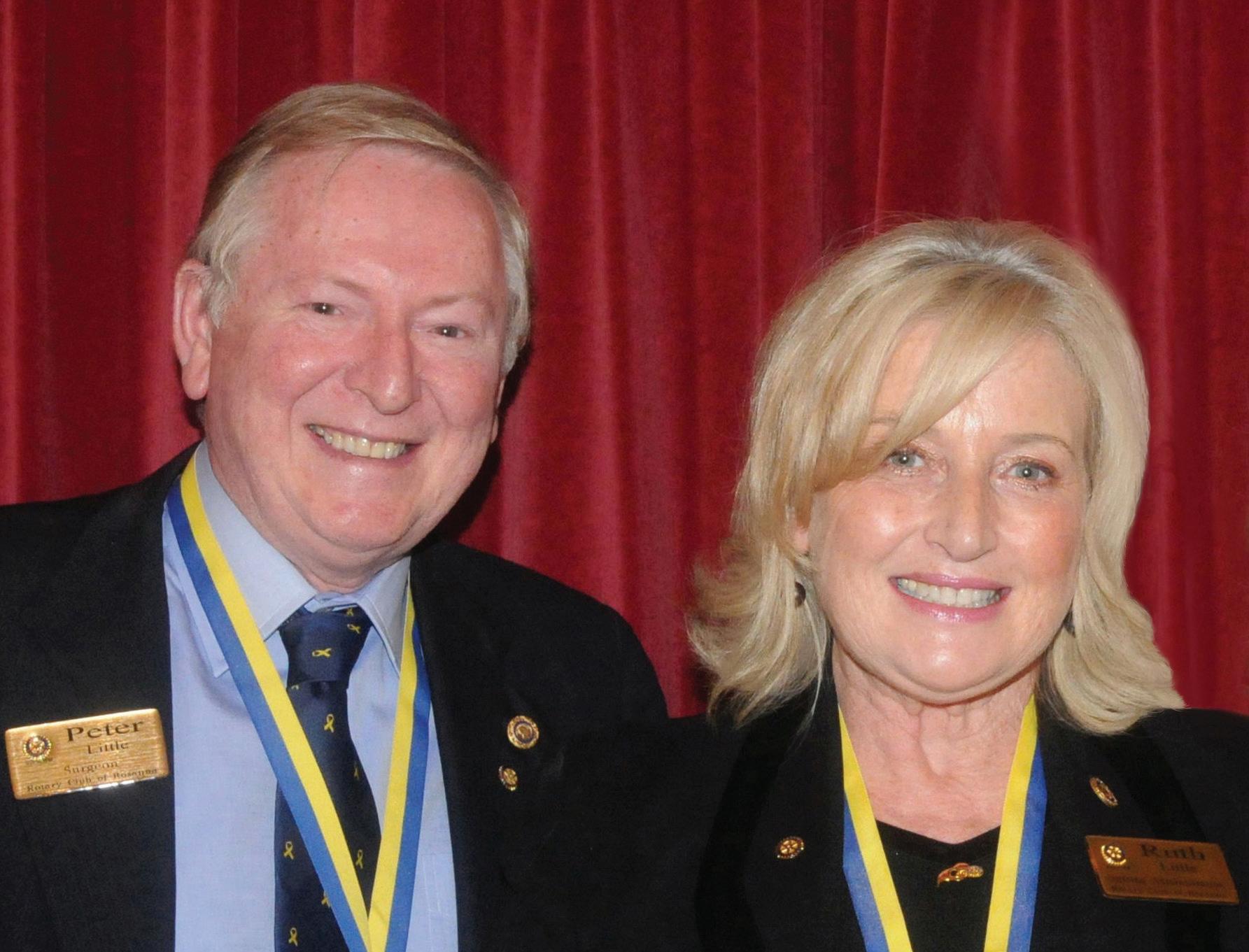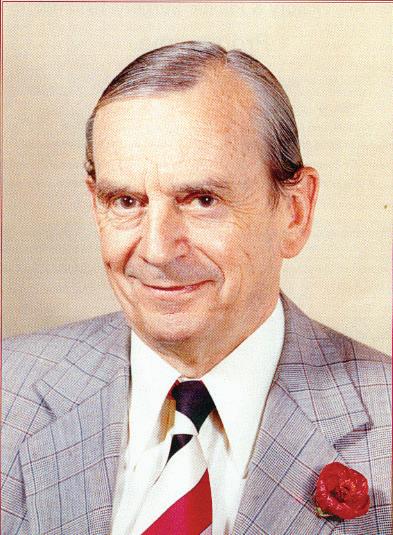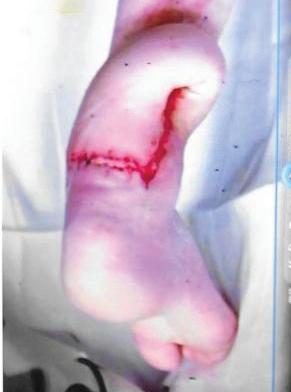
13 minute read
Giving to change lives
Dr Peter Little and Mrs Ruth Little create a lasting legacy for education and research through the Foundation for Surgery.
There’s a proverb about giving that goes like this: “If you have much, give of your wealth; if you have little, give your heart.” For retired general surgeon Dr Peter Little and his wife, Ruth, who died last year, it seems they gave and are still giving both. Throughout their life together they gave continually to those in need with focused intent and great love. “It’s good to give back,” Dr Little said. “I couldn’t have studied medicine without a lot of support from outside, and various scholarships. I also wouldn’t have had the career I had, which I thoroughly enjoyed, without the education and support of the Royal Australasian College of Surgeons (RACS).” In Dr Little’s view, planning their legacies wasn’t about simply assigning and leaving assets, but rather about looking at who really needs help. In his and Ruth’s case there were no immediate family. Sadly, his daughter, a gifted and successful architect, died 10 years ago. So he and Ruth made plans to honour her by creating a scholarship in her name at her former university for a student “who otherwise couldn’t afford to be there”. Similar needs-based awards were created in legacies to Ruth’s old school and the University of Melbourne. After giving to charities and causes around the world throughout their working lives, Dr Little and Ruth had plans to visit some of their international charity projects in their retirement. However, Ruth was diagnosed with colorectal cancer and needed to undergo ongoing chemotherapy and radiotherapy. “Our plans for international charity work all went out the window,” he said. “She carried on with what she could on her laptop, but we were stuck at home. It was a terrible diagnosis and we knew it was incurable.” Aside from restricting her ability to travel, ongoing treatment for cancer didn’t slow Ruth down. Dr Little became her caregiver for the next five years as they continued to run their philanthropic interests. Ruth had to stop doing her field work and resign from some international committees, but “carried on right up to the end, working at home,” Dr Little said. “And she accomplished an awful lot right up to her last three weeks. She arranged our affairs and legacies in great detail and with a lot of thought.” Ruth was a trained midwife and a director of neo-natal intensive care until she became practice manager and cancer support nurse at her husband’s practice. When she was diagnosed with cancer, she made the decision to keep her illness quiet. She was well-known in the surgical community and was concerned people may treat her as if she were sick – which would have interfered with her charity work. “Ruth wanted to carry on as much as she could,” Dr Little said. “It was such a large part of her life.” Dr Little had dealt with colorectal cancer early in his career, and “had no illusions about where they stood.” As a general surgeon, he had an interest in emergency and trauma work, but in later years worked in laparoscopic and breast surgery. He did a training rotation at PANCH (Preston & Northcote Community Hospital) in Melbourne, and enjoyed it so much he returned as a consultant and moved with it when it was relocated to the Northern Hospital in Epping in 1998. Part of Dr Little and Ruth’s legacy will be the creation of a scholarship to be administered by the RACS Foundation of Surgery. It will be a broad scholarship available to a Fellow or Trainee in any specialty, to be used for either research or professional development. It can be awarded to more than one applicant, and carried forward more than one year.
Advertisement
“I think the idea of a lasting scholarship is better than an outright gift,” Dr Little said. The Foundation of Surgery can invest the money and use the income to award the scholarship. “The Foundation has an excellent record of investment and stewardship of such legacies and are given wide discretion by ours.”
The scholarship intentions were finalised during Ruth’s lifetime so she could see it, and Dr Little said they were both very proud to be able to assist surgeons, like he was once helped on his journey to surgery. Philippa Mercer, a general surgeon based in Christchurch, is the new Chair of the New Zealand National Board of the Royal Australasian College of Surgeons (RACS). Philippa is looking forward to working with New Zealand Fellows, Trainees and Specialist International Medical Graduates, her National Board colleagues, RACS staff, and a range of health agencies and organisations to promote New Zealand surgeons and surgery, cultural change, diversity and inclusion. “I fully support the mahi (Māori word for work) that’s under way to make our

Your legacy Each of us finds different ways to make our mark on the world. A legacy fund through the Foundation for Surgery is a gift that will always be remembered. There are two very special ways you can make an extraordinary difference, transform lives and advance your area of speciality or passion: 1. Establish a named perpetual scholarship to see the results of your philanthropy in your lifetime. 2. Leave a bequest – of any size – in your Will and change lives in the future For more information on establishing your legacy, please contact the Foundation for

Surgery at foundation@surgeons.org or call +61 3 9249 1110 today. surgical profession in Aotearoa/New Zealand more culturally competent and safe. “The inequitable health outcomes for Māori are totally unacceptable. Through Te Rautaki Māori, our recently adopted Māori health strategy, I’m confident that we can make real progress in terms of attracting more Māori into surgical careers and, equally importantly, building a culturally safe surgical workforce so all patients receive the care they deserve. “Surgeons need to come from a diverse background and be well trained in communication skills, surgical skills, and be prepared to adapt and continue to learn throughout their career. “One thing I have found invaluable throughout my career is staying on the acute roster. The range of patients and their conditions helps you maintain your skills, and means you work with a variety of medical and surgical colleagues across many specialties.” As a medical student, Philippa was attracted to surgery because the surgical runs were the most enjoyable. “The great aspect of General Surgery is that it covers a wide range of elective and emergency surgery while also allowing for subspecialisation. Every hospital needs general surgeons. General Surgery enables me to be involved with my patients’ care pre-, peri- and postoperatively. Often, especially for cancer patients, you have contact, through regular follow ups, with the patient for years. I find that very satisfying.” Philippa is especially interested in promoting more mentoring among the surgical profession. “Surgical Trainees and newly qualified surgeons need support from their experienced colleagues and it’s very satisfying for those who are mentoring to be able to give back some of the skills and knowledge they have acquired during their career. As a more senior surgeon you learn from your Trainees and younger colleagues.” As well as her work at Christchurch Hospital, Philippa has two private practices in the city – a breast surgery practice and a general and endocrine surgery practice. When Philippa isn’t working, she enjoys spending quality time in her home, repaired, finally after the 2011 Christchurch earthquake, with her husband and their two springer spaniels. She also likes roaming the Port Hills and beaches, or relaxing at their holiday home in Golden Bay near the top of the South Island.
The canon of plastic surgery: embodying art and beauty Part I
OPUS LXIV
The word ‘canon’ has a meaning referring, as a general rule, to the establishment of principles of artistic, musical, aesthetic and scientific development. Even Beethoven once sent a thank you letter, a canon, which was a composition with a repeat melody – his simple way of offering gratitude to his medical practitioner in Vienna for services rendered. In Plastic and Reconstructive surgery, we surgically mould, fashion and repair abnormalities from early life and beyond. The correction of deformities, injuries and malignancies are the basis of our reconstructive art. Innovation is essential for any such ongoing surgical change, embracing a wide spectrum of surgical applications. The Canon of Plastic Surgery implies an ever-changing focus, seeking perfection with research resulting from the refinement of techniques. In the mid-1970s, in the early days of my reconstructive career, my mentor in London, Professor Gerald ‘Charlie’ Westbury, of the Westminster (of melanoma and head and neck fame) came to visit us in Melbourne. We managed to see the microsurgical research facilities at St. Vincent’s Hospital on the invitation of the late Bernard ‘Bernie’ O’Brien. Charlie observed “this would have been one of the most advanced microsurgical laboratories in the world!” It continues to the present day, combining research and clinical applications. This reflects Bernie’s commitment to his surgical craft. He was also a keen world traveller visiting many units of international prominence. Following a visit to the American microsurgeon Dr Thomas Krizek, Bernie returned to Melbourne to do the same procedure of a microsurgical reattachment of a dog’s abdominal wall. He was one of the few in the world to achieve this. Bernie’s lab was also involved in refining surgical instruments and microsurgical sutures. A nylon suture is a delicate item. It is finer than a human hair with a diameter of 0.05 millimetres. Interestingly, the needle is attached to the suture by a technique of dipping the thread into molten steel before being polished into a sharp pointed round bodied repair unit. This item, I recall, once featured on the front page of The Age in the mid-1970s. Bernie was a public relations expert, always looking for research funds. Microsurgical instrument development was also part of this costly exercise. The Microsurgical Research Centre, renamed the Bernard O’Brien Institute of Microsurgery, reflected the principles of research with clinical applications that continues to the present day. It is now headed by Ramin Shayan who replaced Professor Wayne Morrison AM, Bernie’s protege. At this centre, international plastic surgeons gathered from the four corners of the globe (a Judean reference to when the earth was presumed to be flat and the four points of the square represented the corners of the flat ‘globe’). They learned their art and their skills and feature in the ‘rogues gallery’ on the first floor. This is a photographic summary of many local and international personalities who have contributed to our specialty. Yes, there have been personality clashes. Let’s not forget that Napoleon’s surgeon Dominique Jean Larrey is reputed to have observed, “deep injuries cause deep scars”. Besides the clinical implications, there was an underlying psychological overtone as well, reflecting vindictive antagonism. Perfection is in the realm of the almighty, as they say. However, perfection even has some earthly proponents. Polykleitos, whose name means ‘much renowned’, was considered the most important sculptor in ancient Greece. He created a new approach called the Kanon, which advocated aesthetic balance formulated on a mathematical background to accomplish artistic perfection in sculptured results. Plato observed it is possible to express beauty mathematically, exemplified in Euler’s equation eiπ + 1 = 0, something I cannot fathom conceptually. Euler is regarded as the mathematical equivalent of a Mozart. Plato went on to say “the mixture of beauty in mathematics may help to explain the Universe”. In plastic surgery measurement and design are part of our basic fundamentals – measure twice and cut once. We used Gillies blue ink to mark out surgical sites before the texta took over. The four pillars of wisdom who influenced my surgical career Over two essays I will list four people
2 3






4
Sir William Manchester who epitomise the characteristics of our reconstructive art and explain how they influenced my own career: I call them my Four Pillars of Wisdom.
Here I will introduce the first two. My New Zealand link My colleagues across the Tasman, Earle Brown and Michael Klaassen, are compiling a book on Sir William ‘Bill’ Manchester (‘Perfection, the life and times of Sir William Manchester’). He was my first mentor. He had a reputation for seeking perfection in everything he did, as in the title of the upcoming publication. The book will be launched in Auckland in the early 2021. When I presented at the international Plastic Surgery Congress in Madrid in 1972, Bill Manchester chaired the session. There I gave my inaugural presentation on the angiotome vascular concept for flap reconstructions – marking flaps confined to dermatomal precincts. This simplified design means any neural component must have an accompanying vascular supply, even without defining random perforators. This technique protects lymphatic and somatic components left in the surrounding tissues when the perforators are not skeletonised. Kinking is avoided. At the conclusion of the talk, chatting over morning tea, Bill said to me, “Felix, I don’t know where you are coming from but continue to develop this interesting concept.” At the time I was a Bernard Sunley research Fellow at the Royal College of Surgeons in London. Over 30 years, these ideas have metamorphosed
Sir Benjamin Rank into the Keystone Perforator Island Flap, which are aligned within the dermatones with fascial support. I gleaned the word “angiotome” from Dorland’s Illustrated Medical Dictionary during those London days, referring to a vascularised segment, and when based on nerve supply as patterned in the dermatome, the word ‘angiotome’ becomes applicable. Bill’s encouragement for my research has been rewarding and he gave it the green light. He had an analytical mind and a heart that sought perfection. He must have taken a page out of Voltaire’s writing, which declared, “Perfection is the enemy of good.”
Sir Benjamin ‘Benny’ Rank was my Melbourne link and an encyclopedic wonder of the reconstructive art. At the Victorian Plastic Surgery Unit (VPSU) at PANCH (Preston & Northcote Community Hospital), the consultants from the major teaching hospitals in Melbourne voluntarily gave their sessional time to operate on public cases, as a contribution to our plastic surgical teaching - including me. The VPSU was Benny’s baby. When we learn a range of techniques from various positive personalities, we pick the pearls best suited to our own way of operating to achieve an element of perfection. Benny had the mind of a disciplinarian and one learned to never arrive late. He had a heart of gold, yet a desire to achieve the best possible patient outcome. This was preeminent in his surgical ethos. He also
5

taught me the art of politics – how to deal with hospital administrators. He was my primary mentor, the doyen of plastic surgery in Australia at that time, and he invited me to join the Melbourne scene to continue his stewardship.
Associate Professor Felix Behan
Images on page one and two: 1: Shows Major Rank in his military uniform marking out the design for detachment of a Gillies tubed pedicle from the right scapular region before it is staged and transferred to another distal site. 2: Checking the viability and directional flow of the tube before transfer, linking fourth to the eighth intercostal perforators. 3: The healed tube pedicle over the right scapular before detachment. 4: Further staged reconstruction with attachment to the abdominal wall via the wrist. 5: Shows the reconstruction of the tube pedicle after multiple procedures waltzed down from the back to the groin via the arm before definitively attached over the exposed tendo-achilles of the right ankle.







